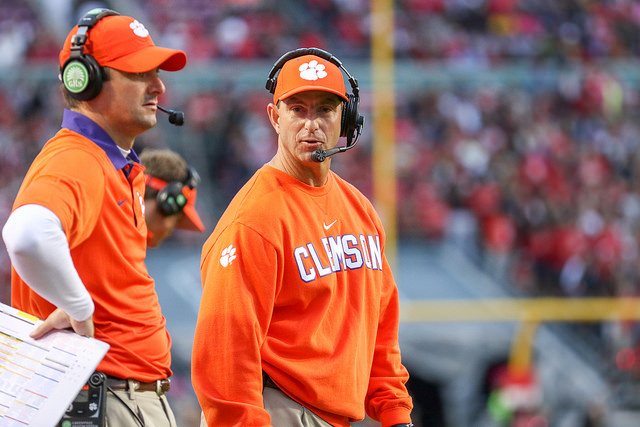
Does having a large coaching and support staff give a football team a competitive edge? According to a December 2017, article in Sports Business Daily, ESPN’s Chris Fowler believes it does. Fowler remarked during the Alabama-Florida State season opener last year that enlarged coaching staffs lead to “endless resources” of football brain power. More resources may very well be one of the reasons a number of successful teams have doubled or even tripled their staff in recent years, so much so that the NCAA has sought to place limits on these coaching staffs.
The Issue
The NCAA has already had rules on the books policing coaching staffs, allowing for ten on the field assistant coaching positions, limits as to how many headsets were allowed in the box and on the sidelines, limits on the credentialed team personnel allowed on the sideline, as well as how many individuals from the staff were allowed to participate in on-campus recruiting opportunities. However, these rules have not been strictly enforced, causing many to say that larger schools with the financial resources to grow their staff are being given an unfair advantage over schools with smaller staffs.
A number of new positions added to the fold including analysts, chief of staff, and other non-coaching titles that allow individuals — often veteran head coaches, coordinators, and former NFL assistants — to participate with the team without technically violating any current rules.
The NCAA looked to clarify the rules by putting forth a number of proposals.
Changing the Rules
One proposal put forth in 2017 would limit the number of individuals allowed to participate in on-campus recruiting to 30. These 30 individuals would include the head coach and ten positions coaches, as well as four graduate assistant coaches. All thirty individuals would be designated by the school before the start of the first preseason practice, and all designated personnel would be required to pass an NCAA recruiting exam each year before participating in recruiting practices such as written and verbal communication with prospective student-athletes and their parents or legal guardians.
In January, this proposal was tabled in order to have more discussion with coaches as to how the rule would work.
Another proposal, approved in May, clarified the maximum number of headsets allowed during games. The new rule allows 20 headsets per team, including 15 for the coach, assistants, and four graduate assistants, as well as four players and one individual in a non-coaching role, such as the staffer who charts plays. Headsets for security, game management, and medical personnel are not included in the 20 headset rule.
But will these new rules level the playing field? On gameday perhaps, but during the week, in which you often times hear coaches say games are won before they are ever played, likely not.
Institution’s with the resources will still have the ability to hire as many coaches as they can house to game plan, strategize, break down tape, and study any and every situation. Until the NCAA decides to limit or regulate a total number of people that can be involved with the program and in a football capacity, schools with the ability to hire these staffs will continue to do so. As they should.
